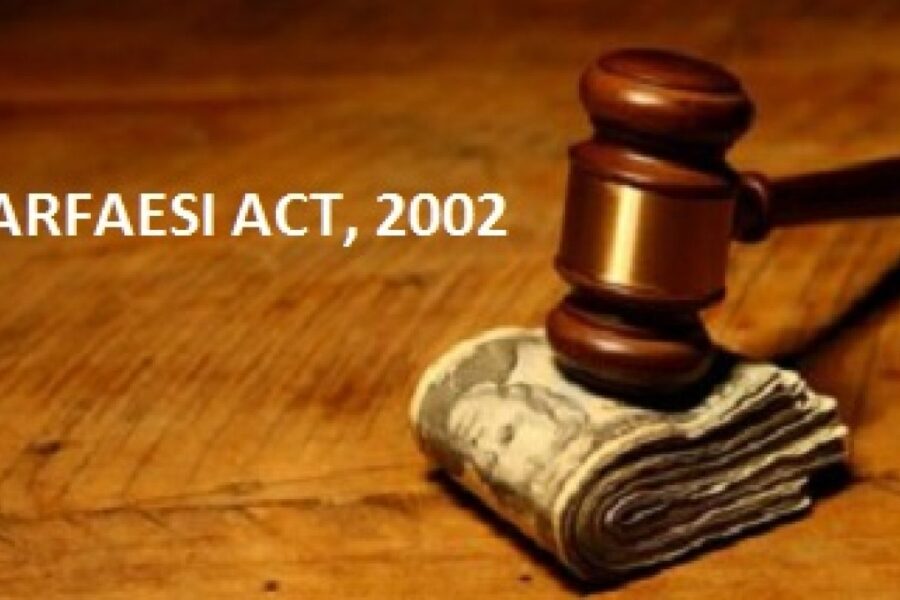Meaning
SARFAESI stands for “Securitization and Reconstruction of Financial Assets and Enforcement of Security Interest”. The SARFAESI Act enables banks and other financial institutions for sale by auction of commercial or residential properties to recover a loan when a borrower defaults in repaying the loan amount. Therefore, the SARFAESI Act, 2002 facilitates banks to minimize their Non-Performing Assets (NPAs) through recovery techniques and reconstruction.
SARFAESI Act states that banks can attach the property of a borrower without approaching the court except in case of agricultural land. SARFAESI Act, 2002 applies only to the cases involving secured loans in which banks are able to exercise underlying securities like hypothecation, mortgage, pledge etc. A court order is not needed unless the security is fraudulent or invalid. In case of unsecured assets, the bank would need to approach court and present a case against the defaulter.
The Act allows secured creditors (Banks) to enforce security interests for recovery of its dues without court intervention as long as security interest has been duly charged in favor of the bank.
Object and scope of the Act
1. Registration and regulation of securitization companies or reconstruction companies by Reserve Bank of India.
2. Securitization and reconstruction of financial assets.
3. Enforcement of security interest.
4. The said Act empowers and authorizes the secured creditors to take possession of their securities, to deal with them without resort to court or tribunal and also alternatively to authorize any Securitization or Reconstruction Company to purchase financial assets of any bank or financial institution.
5.The Act has been invested with the overriding effect over the other laws and it shall be in addition to and not derogation of certain laws.
6.The Act is extended to the whole of India.
How it works?
The Act gives authority to a bank or financial institution to confiscate the property of a defaulting borrower. If the borrowers of a loan default in payment of a loan or installment of a loan, the financial institution may declare the account as Non-Performing Assets. The defaulting borrower may be sent notices by the banks or financial institution to settle their liabilities within a period of 60 days. When the defaulting borrower does not act as per the notice by the bank or financial institution, then the SARFAESI Act provides the following remedy to a bank:
•Take possession of the security for the loan
•Lease, sell or assign the right to the security
•Deal with the same or appoint any person to deal with the same
The SARFAESI Act also enables the setting up of Asset Reconstruction Companies (ARC’s) under the regulation of RBI to purchase assets from banks and financial institutions. The Act enables the banks and financial institutions to sell financial assets to asset reconstruction companies (ARC’s). RBI has issued guidelines to banks regarding the procedure to be adopted for the sale of financial assets to ARC’s.
Features of the Act
SARFAESI Act safeguards banks and financial assets against losses. Characteristics of the Act can be defined as follows:
- Enforcement of security interest: The Act enforces the security interest by the secured creditors without court intervention.
- Reconstruction of financial assets: The Act permits banker and financial institutions to take adequate measures of management, sale, settlements, reconstruction of debt or take any possession under the RBI guidelines from time to time.
- Act as a bank or financial institution agent: SARFAESI Act,2002 serves as the administrator of the secured assets provided by the financial institutions and makes sure that dues are realized in time.
When do properties come under this act?
- When a loan becomes default and some conditions are not fulfilled, banks classify the loan as NPA and Auction it.
- Provisions of this Act apply only to NPA loans with outstanding over Rs. 1 lac
- NPA loan accounts where the outstanding amount is less than 20% of the principal and interest cannot be treated under this Act.
Pre- Conditions
Four conditions are required under this Act for enforcing the rights of a creditor:
- The debt is secured
- The debt has been recorded as an NPA by the banks
- The arrears are one lakh and more and in excess of 20% of the original loan amount and interest accrued thereon.
- The security that will be enforced is not an agricultural property
Procedure of Recovery
The Act provides for two principal methods of recovery of the NPA’s as follows:
- Securitization: Issuance of marketable securities, supported by a pool of existing assets like auto loan or home loans. Once an asset is transformed into a marketable security, it is sold. A securitization company or reconstruction company can raise funds from only the QIB (Qualified Institutional Buyers) by creating schemes for purchasing financial assets.
- Asset Reconstruction: Implementation of SARFAESI Act has ushered in the Assets Reconstruction Companies in India. It can be done either by appropriate management of borrower’s business or by taking control of it or by selling part or whole of the business or by rescheduling payment of debts payable by the borrower enforcement of the security interest in accordance with the provisions of this Act.
Conclusion
High NPA’s level has resulted in reduced interest income and loan loss provisioning needs that decreased the banks’ profitability. The Act aims to make Banks and Financial Institutions more robust to recover NPAs more rapidly. The Act gives power to banks and Financial Institutions to take possession of charged assets without Courts involvement and dispose of them.
CONTRIBUTED BY: DIWANSHI ARYA (INTERN)

